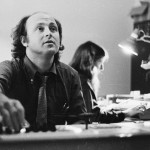Even though one of the TR-22 2 inch VTRs had an “electronic splicer” option installed, the first actual videotape editing done on my watch was in the editing room that Bob Swanner. and I built. The department already owned a CVS 504 TBC, but it had not been used to any extent. The editing room project taught me a whole BUNCH of lessons that have stood me in good stead over the years.
I researched the VTR marketplace before purchasing the Panasonic machines. During that brief window of time, Panasonic had 3/4 inch VTRs with framing servos, and the Sony 2850 did not. I had been hating “whip edits” for years prior to joining RTVF, and selected the machines with the framing servos.
Convergence was marketing the ECS 1 B. It required both mechanical and electrical modification of the VTRs. The mechanical modification was extreme. The intent of the mod was to permit the machine to have variable speed control over the tape speed both forward and in reverse. The Panasonic VTR had not been designed to do that, so tape guidance problems were frequent.
The capstan belts kept slipping off the flywheels of the machines. Bob came up with a doozie of a contraption to keep the belts from popping off.
The tape position was determined by counting control track pulses, and of course the back and forth nature of editing guaranteed some slippage of the edit points.
But even with the limitations, the editing room dramatically advanced the capability of the department. We connected the source deck to the TBC, and at last were able to use 3/4 as a source to the switcher. Outside productions could be undertaken by renting a “good” camera and shooting on a portable 3/4 machine. An editing class was added to the curriculum.






